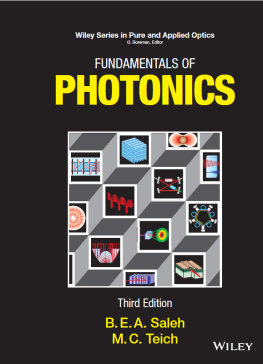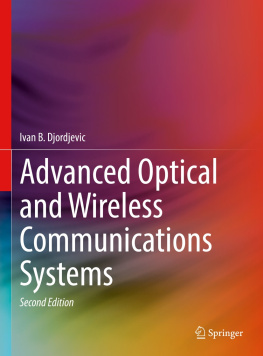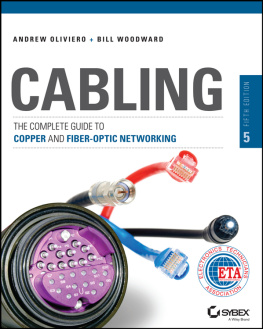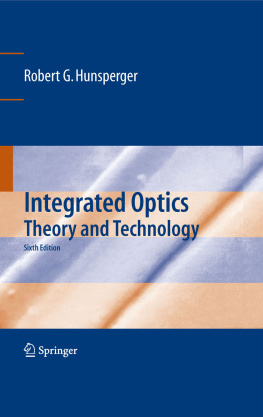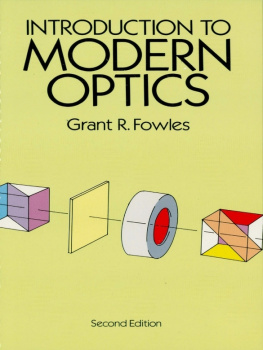
FUNDAMENTALS OF PHOTONICS
THIRD EDITION
BAHAA E. A. SALEH
University of Central Florida
Boston University
MALVIN CARL TEICH
Boston University
Columbia University
This edition first published 2019
2019 by John Wiley & Sons, Inc.
All rights reserved. No part of this publication may be reproduced, stored in a retrieval system, or transmitted, in any form or by any means, electronic, mechanical, photocopying, recording or otherwise, except as permitted by law. Advice on how to obtain permission to reuse material from this title is available at http://www.wiley.com/go/permissions.
The rights of Bahaa E. A. Saleh and Malvin Carl Teich to be identified as the authors of the editorial material in this work have been asserted in accordance with law.
Registered Office
John Wiley & Sons, Inc., 111 River Street, Hoboken, NJ 07030, USA
Editorial Office
111 River Street, Hoboken, NJ 07030, USA
For details of our global editorial offices, customer services, and more information about Wiley products visit us at www.wiley.com.
Wiley also publishes its books in a variety of electronic formats and by print-on-demand. Some content that appears in standard print versions of this book may not be available in other formats.
Limit of Liability/Disclaimer of Warranty
In view of ongoing research, equipment modifications, changes in governmental regulations, and the constant flow of information relating to the use of experimental reagents, equipment, and devices, the reader is urged to review and evaluate the information provided in the package insert or instructions for each chemical, piece of equipment, reagent, or device for, among other things, any changes in the instructions or indication of usage and for added warnings and precautions. While the publisher and authors have used their best efforts in preparing this work, they make no representations or warranties with respect to the accuracy or completeness of the contents of this work and specifically disclaim all warranties, including without limitation any implied warranties of merchantability or fitness for a particular purpose. No warranty may be created or extended by sales representatives, written sales materials or promotional statements for this work. The fact that an organization, website, or product is referred to in this work as a citation and/or potential source of further information does not mean that the publisher and authors endorse the information or services the organization, website, or product may provide or recommendations it may make. This work is sold with the understanding that the publisher is not engaged in rendering professional services. The advice and strategies contained herein may not be suitable for your situation. You should consult with a specialist where appropriate. Further, readers should be aware that websites listed in this work may have changed or disappeared between when this work was written and when it is read. Neither the publisher nor authors shall be liable for any loss of profit or any other commercial damages, including but not limited to special, incidental, consequential, or other damages.
Library of Congress Cataloging-in-Publication Data is available.
Volume Set ISBN: 9781119506874
Volume I ISBN: 9781119506867
Volume II ISBN: 9781119506898
Cover design by Wiley
Cover image: Courtesy of B. E. A. Saleh and M. C. Teich
PREFACE TO THE THIRD EDITION
Since the publication of the Second Edition in 2007, Fundamentals of Photonics has maintained its worldwide prominence as a self-contained, up-to-date, introductory-level textbook that features a blend of theory and applications. It has been reprinted dozens of times and been translated into German and Chinese, as well as Czech and Japanese. The Third Edition incorporates many of the scientific and technological developments in photonics that have taken place in the past decade and strives to be cutting-edge.
Optics and Photonics
Before usage of the term photonics became commonplace at the time of the First Edition in the early 1990s, the field was characterized by a collection of appellations that were not always clearly delineated. Terms such as quantum electronics, optoelectronics, electro-optics, and lightwave technology were widely used. Though there was a lack of agreement about the precise meanings of these terms, there was nevertheless a vague consensus regarding their usage. Most of these terms have since receded from general use, although some have retained their presence in the titles of technical journals and academic courses.
Now, more than 25 years later, the term Optics along with the term Photonics, as well as their combination Optics & Photonics, have prevailed. The distinction between optics and photonics remains somewhat fuzzy, however, and there is a degree of overlap between the two arenas. Hence, there is some arbitrariness in the manner in which the chapters of this book are allocated to its two volumes, Part I: Optics and Part II: Photonics. From a broad perspective, the term Optics is taken to signify free-space and guided-wave propagation, and to include topics such as interference, diffraction, imaging, statistical optics, and photon optics. The term Photonics, in contrast, is understood to include topics that rely on the interaction of light and matter, and is dedicated to the study of devices and systems. As the miniaturization of components and systems continues to progress and foster emerging technologies such as nanophotonics and biophotonics, the importance of photonics continues to advance.
Printed and Electronic Versions
The Third Edition appears in four versions:
- A printed version.
- An eBook in the form of an ePDF file that mimics the printed version.
- An eBook in the form of a standard ePUB.
- An eBook in the form of an enhanced ePUB with animations for selected figures.
In its printed form, the text consists of two volumes, each of which contains the Table of Contents and Index for both volumes along with the Appendices and List of Symbols:
- Part I: Optics, contains the first thirteen chapters.
- Part II: Photonics, contains the remaining twelve chapters.
The material in the eBook versions is identical to that in the printed version except that all 25 chapters reside in a single electronic file. The various eBooks enjoy the following features:
- Hyperlinked table of contents at the beginning of the text.
- Hyperlinked table of contents as an optional sidebar.
- Hyperlinked index.
- Hyperlinked section titles, equations, and figures throughout.
- Animations for selected figures in the enhanced ePUB.
Presentation
Exercises, examples, reading lists, and appendices. Each chapter of the Third Edition contains exercises, problem sets, and an extensive reading list. Examples are included throughout to emphasize the concepts governing applications of current interest. Appendices summarize the properties of one-and two-dimensional Fourier transforms, linear systems, and modes of linear systems. Important equations are highlighted by boxes and labels to facilitate retrieval.
Symbols, notation, units, and conventions. We make use of the symbols, notation, units, and conventions commonly used in the photonics literature. Because of the broad spectrum of topics covered, different fonts are often used to delineate the multiple meanings of various symbols; a list of symbols, units, abbreviations, and acronyms follows the appendices. We adhere to the International System of Units (SI units). This modern form of the metric system is based on the meter, kilogram, second, ampere, kelvin, candela, and mole, and is coupled with a collection of prefixes (specified on the inside back cover of the text) that indicate multiplication or division by various powers of ten. However, the reader is cautioned that photonics in the service of different areas of science can make use of different conventions and symbols. In , where the definitions we use for right (left) circularly polarized light are in accord with general usage in optics, but are opposite those generally used in engineering. These distinctions are often highlighted by
Next page
